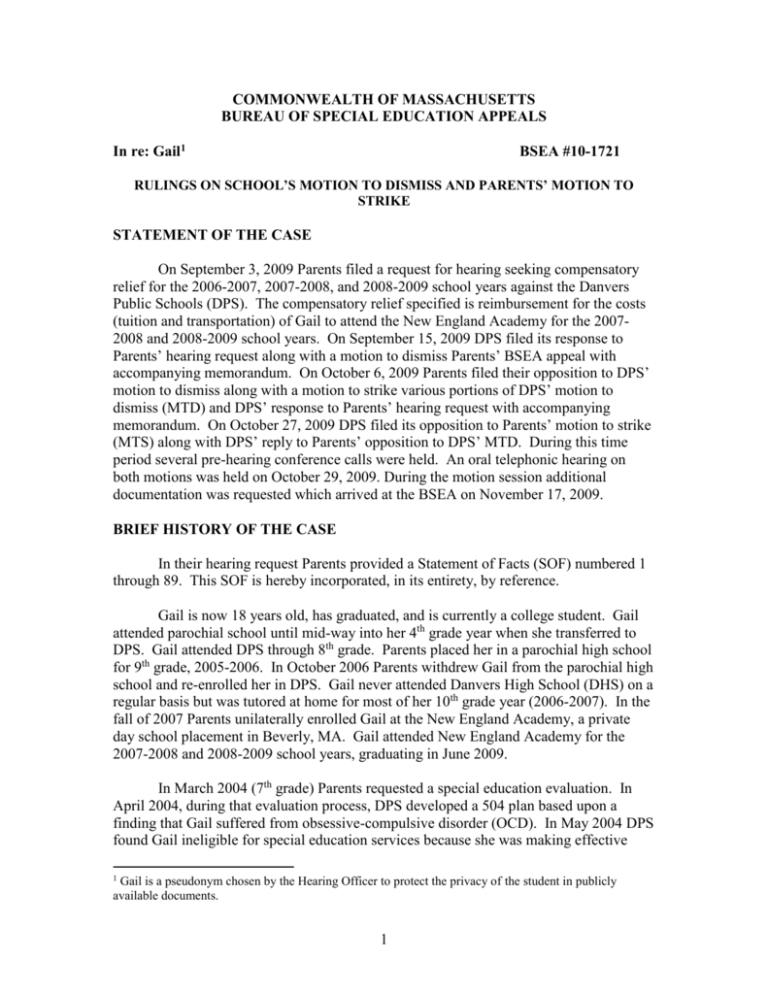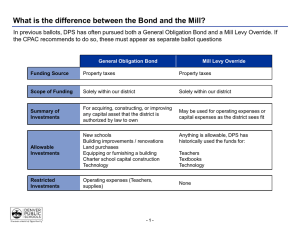Danvers P.S. BSEA #10-1721 - Massachusetts Department of
advertisement

COMMONWEALTH OF MASSACHUSETTS BUREAU OF SPECIAL EDUCATION APPEALS In re: Gail1 BSEA #10-1721 RULINGS ON SCHOOL’S MOTION TO DISMISS AND PARENTS’ MOTION TO STRIKE STATEMENT OF THE CASE On September 3, 2009 Parents filed a request for hearing seeking compensatory relief for the 2006-2007, 2007-2008, and 2008-2009 school years against the Danvers Public Schools (DPS). The compensatory relief specified is reimbursement for the costs (tuition and transportation) of Gail to attend the New England Academy for the 20072008 and 2008-2009 school years. On September 15, 2009 DPS filed its response to Parents’ hearing request along with a motion to dismiss Parents’ BSEA appeal with accompanying memorandum. On October 6, 2009 Parents filed their opposition to DPS’ motion to dismiss along with a motion to strike various portions of DPS’ motion to dismiss (MTD) and DPS’ response to Parents’ hearing request with accompanying memorandum. On October 27, 2009 DPS filed its opposition to Parents’ motion to strike (MTS) along with DPS’ reply to Parents’ opposition to DPS’ MTD. During this time period several pre-hearing conference calls were held. An oral telephonic hearing on both motions was held on October 29, 2009. During the motion session additional documentation was requested which arrived at the BSEA on November 17, 2009. BRIEF HISTORY OF THE CASE In their hearing request Parents provided a Statement of Facts (SOF) numbered 1 through 89. This SOF is hereby incorporated, in its entirety, by reference. Gail is now 18 years old, has graduated, and is currently a college student. Gail attended parochial school until mid-way into her 4th grade year when she transferred to DPS. Gail attended DPS through 8th grade. Parents placed her in a parochial high school for 9th grade, 2005-2006. In October 2006 Parents withdrew Gail from the parochial high school and re-enrolled her in DPS. Gail never attended Danvers High School (DHS) on a regular basis but was tutored at home for most of her 10th grade year (2006-2007). In the fall of 2007 Parents unilaterally enrolled Gail at the New England Academy, a private day school placement in Beverly, MA. Gail attended New England Academy for the 2007-2008 and 2008-2009 school years, graduating in June 2009. In March 2004 (7th grade) Parents requested a special education evaluation. In April 2004, during that evaluation process, DPS developed a 504 plan based upon a finding that Gail suffered from obsessive-compulsive disorder (OCD). In May 2004 DPS found Gail ineligible for special education services because she was making effective 1 Gail is a pseudonym chosen by the Hearing Officer to protect the privacy of the student in publicly available documents. 1 progress in school and was being provided accommodations through her 504 plan. During 8th grade DPS again provided Gail with a 504 plan based upon an anxiety disorder with compulsive features and mood instability. During her 9th grade year at the parochial high school and her re-enrollment in DPS early into her 10th grade year, Gail was additionally diagnosed with a bi-polar disorder and depression. These emotional disabilities prevented her from regularly attending DHS. DPS developed a new 504 plan providing Gail with 10 hours per week of home tutoring. Also in October 2006, DPS requested to do another special education evaluation to which Parents consented. However, the evaluation was postponed due to Gail’s emotional state (she was hospitalized in January 2007) until February 2007. This psychoeducational evaluation found Gail to have an average cognitive profile and academic skills commensurate with or better than her peers, but with severe anxieties and compulsive behaviors which affected her social and emotional functioning. In late February 2007 a team meeting was held and DPS found Gail eligible for special education services. In March 2007 DPS developed an Individual Education Plan (IEP) placing Gail at the Short Term Assessment and Reintergration (STAR) program at North Shore Educational Consortum which was accepted by Parents. This IEP was effective for one year through March 2008 although the only services specified was the 45 day assessment program at STAR. Gail only attended STAR for parts of 2 weeks before developing severe anxiety. In April 2007 Parents rescinded their consent to STAR and requested the resumption of home tutoring until a more permanent solution could be found. DPS initially refused to provide home tutoring and demanded that Gail attend STAR for the remainder of the 45 day assessment period. In late April 2007 Parents began private tutoring. In late May 2007 DPS agreed to pay for such tutoring. Also in late May 2007 DPS conducted a team meeting but made no changes to Gail’s IEP. During the 2007 summer Gail was privately evaluated and Parents decided to place her at the New England Academy (NEA). Mr. Plosker, the director of NEA, informed Parents that it was against NEA policy to admit students who were intending to seek reimbursement for private placement from a public school district. Parents told Mr. Plosker that they hoped to convince DPS to fund Gail’s placement at NEA. Gail began at NEA in August 2007. (See SOF 56, 57, 58.) On September 18, 2007 DPS convened a team meeting to discuss Parents’ private evaluation and discuss placement options. Parents asked DPS to support Gail’s placement at NEA while DPS offered placement at Essex Academy (part of the Greater Lawrence Educational Collaborative) along with 2 other potential options. Gail’s IEP expired on March 18, 2008. In January 2008 a team meeting was scheduled for March 17, 2008. Father responded that he was unable to attend on March 17, 2008 and offered 19 alternative dates prior to March 17, 2008. DPS did not reschedule the team meeting until June 2008. On June 13, 2008 the team reconvened and DPS proposed a new IEP for 2008-2009 placing Gail at Essex Academy. Also on June 13, 2008: 2 [Parents] told Danvers at the team meeting that they intended to send [Gail] back to New England Academy for the 2008-2009 school year and that they wanted Danvers to fund this placement. (SOF-73) [Parents] did not send written notice to Danvers of their intention to place [Gail] at New England Academy and seek reimbursement for either the 2007-2008 or 2008-2009 school year because they had been told by the Director of New England Academy that he would terminate [Gail’s] placement if [Parents] commenced legal action against Danvers for tuition reimbursement. (SOF-74) Parents rejected DPS’ proposed IEP and placement of Gail at Essex Academy and Gail continued at NEA for the 2008-2009 school year, graduating from NEA in June 2009. STATEMENT OF POSTIONS – MTD DPS’s position is that Parents’ hearing request should be dismissed on the following grounds: 1) the claims are barred by the IDEA’s two year statue of limitations; 2) the equitable claims for compensatory relief/reimbursement should be denied because Parents have not acted in good faith; and 3) the claims for reimbursement for the costs of Parents’ unilateral placement at NEA is barred because Parents failed to inform DPS of their intent to place Gail at NEA as required by the IDEA. Parents’ position is that: 1) their claims are not barred by the relevant statutes of limitations; 2) they complied with the oral notice requirements concerning unilateral placement or, if not, were prevented from doing so by DPS’ actions; 3) that equitable considerations weigh against the dismissal of Parents’ action for any failure to provide notice; and 4) parents have acted in good faith and are entitled to equitable relief. STATEMENT OF POSITONS – MTS Parents’ position is that specific portions of DPS’ MTD and DPS’ response to Parents’ hearing request should be stricken from the record on the grounds that they are immaterial, impertinent and scandalous. DPS’ position is that the material Parents seek to strike is material, relevant, accurate and speaks to the essence of Parents’ equitable remedies claims. RULINGS Based upon the written motions, arguments and memorandum submitted; the written documentation submitted including Parents’ SOF, which was not rebutted by or objected to by DPS and used as facts in DPS’ written arguments/memorandum; the oral arguments presented; and a review of the applicable law, I rule as follows: I. DPS’ MTD regarding the 2006-2007 school year is GRANTED. 3 II. DPS’ MTD regarding the 2007-2008 school year is GRANTED IN PART and DENIED IN PART. III. DPS’ MTD regarding the 2008-2009 school year is DENIED. IV. PARENTS’ MTS is DENIED. My analysis follows. Under 801 CMR 1.01(7(g)(3) – Standard Adjudicatory Rules of Practices and Procedure; Rule XVII(B)(4) – Hearing Rules for Special Education Appeals; F.R.C.P. Rule 12(b)(6); or M.R.C.P. Rule 12(b)(6), the standards applicable to a motion to dismiss are essentially identical: A motion to dismiss may be granted if the party requesting the appeal or hearing fails to state a claim upon which relief may be granted. Therefore, a hearing officer, considering all of the allegations in a hearing request to be true, may dismiss the case if he or she cannot grant relief under either the federal or state special education statutes (20 U.S.C. §1400 et seq. or M.G.L. c.71B) or the relevant portions of Section 504 (29 U.S.C § 794). I. 20 U.S.C. §1415(f)(3)(c) Timeline for requesting hearing provides, in pertinent part: A parent or agency shall request an impartial due process hearing within 2 years of the date parent or agency knew or should have known about the alleged action that forms that basis of the complaint. Parents hearing request was filed on September 3, 2009. Based upon the above cited IDEA statute of limitations, Parents can “reach back” to September 3, 2007. Therefore, claims arising from the 2006-2007 school year through the 2007 summer are time barred pursuant to 20 U.S.C. §1415(f)(3)(C). Parents assert that the 2006-2007 school year is not time barred because they bring this action under both 20 U.S.C. §1400 et seq. (IDEA) and 29 U.S.C. §794 (504). Parents argue that Section 504 has no statute of limitations (SOL) so states may “borrow” a SOL from the most analogous state statute. Prior to the 2004 Amendments to the IDEA (which established the two year SOL for IDEA claims) the IDEA also had no SOL and Massachusetts applied a three year SOL to both IDEA and 504 claims, borrowing from the most analogous Massachusetts statute concerning civil rights. See In re: Fall River Public Schools 5 MSER 183 (1999) (Crane, H.O.) 4 However, in 2004 Congress passed the IDEA Amendments which established the IDEA’s two year SOL cited above. Quoting from 15 MSER 100 In re: Boston Public Schools (March 23, 2009) (Byrne, H.O.): When Congress rewrote the IDEA in 2004, it specifically addressed the lack of a statute of limitations in prior versions. Citing the need for uniformity and predictability of procedural expectations, as well as reaffirming its intent that the IDEA be a statute geared to prospective educational substance, Congress selected a two year filing deadline for IDEA claims. By doing so, it rendered the various limitation periods established by courts, regulators, and administrative agencies considering IDEA claims obsolete. Just as Hearing Officer Crane decided in Fall River that IDEA and 504 claims are so closely related that applicable statutes of limitation should be the same, here, where the factual basis of the Parent’s IDEA and Section 504 claims are identical, there is no good reason substantively or procedurally to separate the claims for unequal treatment. Furthermore Massachusetts has already, by default, imported the IDEA’s two year limitations period to actions filed under MGL c.71B. It is MGL c.71B that is most closely analogous to claims contemplated under Section 504 concerning deprivation of educational access and opportunity on the basis of disability. As the BSEA has been designated the due process agency to hear Section 504 administrative appeals concerning special education, the same two year statute of limitations applicable in MGL. c.71B actions should be applied to corollary claims under Section 504. There is no need or justification to look to an unrelated statue governing a different area of law for appropriate time limits on Section 504 claims involving substantive special education programming. The Hearing Officer went to find: I find that the two year statute of limitations set out in IDEA 2004 should govern claims made under Section 504 which are based on the same underlying facts and seek the same remedies as the concurrent IDEA action filed at the BSEA. Further, on November 2, 2009 the United States Court of Appeals for the 3rd Circuit also found that Section 504 was more akin to the IDEA than a state law governing personal injury claims and that the IDEA’s two year statute of limitations should apply to Section 504 claims. See PP ex rel Michael P. v. West Chester Area School District 109 LRP 69252; 2009 WL 3526372; --- F. 3d. --- 3rd Cir. (2009). Quoting from that case: The IDEA and § 504 of the Rehabilitation Act do similar statutory work. The IDEA protects the rights of disabled children by mandating that public educational institutions indentify and effectively educate those children, or pay for their education elsewhere if they require specialized services that the public institution cannot provide. Section 504 of the Rehabilitation Act is parallel to the 5 IDEA in its protection of disabled students: it protects the rights of disabled children by prohibiting discrimination against students on the basis of disability, and it has child find, evaluation, and FAPE requirements, like the IDEA. The Rehabilitation act is certainly closer to subject matter and goals to the IDEA than to the Pennsylvania personal injury statute, which deals with torts against person and property…. We also note that there are few federal statutes as closely related, and under which such similar claims may be brought, as the IDEA and § 504 of the Rehabilitation Act…. We are convinced that the IDEA’s limitations period is a better fit for education claims made under the Rehabilitation Act than the personal injury statute of limitations. Although it appears that none of our sister circuits have faced this issue, district courts confronting the issue have concluded that claims for education under the Rehabilitation Act should be governed by the IDEA’s statute of limitations. See, e.g., Bell v. Bd. of Educ of Albuquerque Pub Sch., No. 061137, 2008 WL 4104070 (D.N.M. Mar. 26, 2008) (holding that the IDEA’s limitations period applies to Rehabilitation Act claims where all claims are for education and there are no pure discrimination claims made under the Rehabilitation Act). Based upon the above BSEA/administrative, U.S. district court, and U.S. court of appeals cases, I conclude that the two year IDEA SOL is the applicable SOL for Section 504 claims in Massachusetts. DPS’ MTD is GRANTED regarding the 2006-2007 school year and 2007 summer. II. 20 U.S.C. §1412 (a)(10)(C)(ii) and (C)(iii) provide, in pertinent part: (C) Payment for education of children enrolled in private schools without consent of or referral by the public agency…. (ii) Reimbursement for private school placement. If the parents of a child with a disability, who previously received special education and related services under the authority of a public agency, enroll the child in a private elementary school or secondary school without the consent of or referral by the public agency, a court or hearing officer may require the agency to reimburse the parents for the cost of that enrollment if the court or hearing officer finds that the agency had not made a free appropriate public education available to the child in a timely manner prior to that enrollment. (iii) Limitation on reimbursement. The cost of reimbursement described in clause 6 (ii) may be reduced or denied – (I) if – (aa) at the most recent IEP meeting that the parents attended prior to removal of the child from the public school, the parents did not inform the IEP Team that they were rejecting the placement proposed by the public agency to provide a free appropriate public education to their child, including stating their concerns and their intent to enroll their child in a private school at public expense; or (bb) 10 business days (including any holidays that occur on a business day) prior to the removal of the child from the public school, the parents did not give written notice to the public agency of the information described in item (aa); See also 34 CFR 300.148(b) and (c). As SOF-74 (quoted above) makes clear, Parents never sent written notice to DPS of their intention to place Gail at NES or seek reimbursement from DPS for either the 2007-2008 or 2008-2009 school years because the director of NEA, Mr. Plosker, had informed Parents that Gail would be terminated at NEA if Parents commenced legal action against DPS for tuition reimbursement. This NEA policy is not a secret nor is it being applied just to Parents/DPS in this case. It is a well established publicized policy that is clearly articulated on page 5 of NEA’s rather lengthy Student Handbook. This NEA policy states: Privately Placed Students: For privately placed students, their parent/guardian will initiate application and follow the above admissions procedures, excluding the involvement of their LEA. It is New England Academy’s policy not to accept “unilaterally” placed students. However, parents/guardians can place their child at New England Academy under the following policy: a. Parent/guardian agrees to not pursue their public school district for funding associated with the student’s placement at New England Academy. b. The parent(s) agree to forever refrain from initiating any legal action of any kind, including, but not limited to, filing a request for hearing with the Massachusetts Bureau of Special Education Appeals, to seek public funding for New England Academy from their local school district. c. The parent(s) agree to sign a legal contract (see appendix), agreeing to the New England Academy private placement policy. Further, on the NEA website its policy concerning unilateral placements is also plainly articulated in a question and answer format: Question: Can I place my child privately at New England Academy? 7 Answer: Yes, parents have the choice of privately placing their child at New England Academy if the parent agrees not to pursue their public school for tuition costs. Based upon the above, Parents were acutely aware of the NEA policy prohibiting litigation regarding unilaterally placed students. Further, Parents had been aware of this policy prior to their placement of Gail at NEA. (See SOF-56, 57) Parents argue that DPS prevented them from orally informing DPS that they were going to place Gail at NEA and wanted DPS to reimburse them for their unilateral placement of Gail at NEA because no team meeting took place over the 2007 summer. Parents argue that had such a team meeting occurred, Parents could have orally informed DPS of their intention to place Gail at NEA and seek DPS reimbursement. However, Parents’ SOF-48 confirms that a team meeting was held on May 22, 2007 in which Parents asked DPS to consider placement of Gail at NEA, along with other alternatives to consider (Parents’ Opposition to DPS’ MTD.) This clearly does not meet the oral notice standards specified in 20 U.S.C. §1412(a)(10)(C)(iii)(aa). Parents placed Gail in August 2007 (SOF-58). On September 18, 2007 DSS held another team meeting and Parents then orally requested DPS to support Gail’s placement at NEA while DPS proposed several other placements (SOF-59). Again, this does not meet the oral standards of subsection (aa) because it did not occur prior to the Parents placement of Gail at NEA in August 2008. Parents could have avoided this situation by waiting to place Gail at NEA until after the September 18, 2009 team meeting (subsection aa) or giving DPS written notice 10 business days prior to their August 2007 placement of Gail at NEA (subsection bb). However, I also note that Parents placement of Gail at NEA in August 2007 was more than two years prior to the September 3, 2009 filing of their hearing request with the BSEA-so the IDEA SOL would apply to any placement prior to September 3, 2007. Again, this SOL problem could have been avoided by waiting to enroll Gail at NEA until after the September 18, 2007 team meeting. Based upon just these facts and the applicable law I would ordinarily grant DPS’ MTD for the entire 2007-2008 school year. However, Gail’s last IEP expired on March 18, 2008. DPS was obviously well aware of this because in January 2008 DPS scheduled a team meeting for March 17, 2008. As delineated above, Father was unable to attend the team meeting on March 17, 2008 and offered DPS 19 alternative dates all prior to March 18, 2008 but DPS did not reschedule the team meeting until June 2008. The team convened on June 13, 2008 some three months after Gail’s most recent IEP had expired (Emphasis added.) and thereafter issued an IEP specifying Essex Academy as Gail’s placement for the 2008-2009 school year. Therefore, for some three months from mid March 2008 until mid June 2008 Gail was without any IEP or any placement offering from DPS. (Emphasis added.) Such a situation is a significant violation of the statutory and regulatory scheme of both federal and state special education law. Absent some extremely mitigating circumstances or mutual consent of the parties, such a situation simply cannot be allowed. 8 Therefore, DPS’ MTD regarding the 2007-2008 school year is GRANTED from August/September 2007 to March 18, 2008. DPS’ MTD is DENIED for the period of time from March 18, 2008 to June of 2008 when DPS had proposed no IEP at all for Gail. III. It is undisputed that at the June 18, 2009 team meeting Parents orally informed DPS that they intended to send Gail back to NEA for the 2008-2009 school year and that they wanted DPS to fund Gail’s 2008-2009 placement at NEA. Therefore, Parents have met the statutory standard for oral notice to DPS for the 2008-2009 school year pursuant to 20 U.S.C. § 1412(a)(10)(C)(iii)(aa). DPS’ MTD regarding the 2008-2009 school year is DENIED. IV. Parents move to strike portions of DPS’ response to Parents’ hearing request and DPS’ MTD Memorandum concerning allegations of Parents’ lack of good faith as immaterial, impertinent and scandalous. I find that such references may be potentially material, relevant, and accurate. One need only refer to Parents’ SOF-56, 57, 58, & 74; the NEA Student Handbook page 5 (cited above); and the NEA website Q & A (cited above) to see that Parents’ actions may potentially demonstrate bad faith with regard to both DPS and NEA. Parents’ MTS is DENIED. ORDER 1) DPS’ MTD is GRANTED for the 2006-2007 school year, 2007 summer, and for the 2007-2008 school year from September 2007 until March 18, 2008. 2) DPS’ MTD is DENIED for the periods between March 18, 2008 through Gail’s graduation from NEA in June 2009. 3) Parents’ MTS is DENIED. 4) A pre-hearing conference call will take place on April 15, 2010 at 4:00 p.m. to discuss further proceedings in this case. By the Hearing Officer ___________________________ Raymond Oliver Dated: April 9, 2010 9








